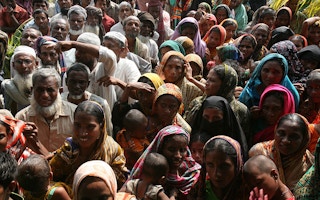According to the Internal Displacement Monitoring Centre, in 2017 more than 18.8 million people were displaced by disasters, 95 per cent of them by weather-related disasters.
Storms and floods were responsible for almost 90 per cent of those displacements, continuing a trend seen over the last decade.
Since 2008, disasters have replaced conflict as the predominant trigger for internal displacement. And we see more and more new records emerge that are fueled by global heating. The rapid escalation of the climate emergency has caused significant displacement in recent years.
Behind all of these numbers and facts, there are people.
The village of Mutua in Mozambique has become the site of a large displacement camp, following cyclones that hit the nation. Three months later, more than 300 people, most of them women and girls, still call the camp home. These families are struggling to rebuild their lives, and many are afraid to return to the villages where their houses were engulfed by water.
A mother of three has been living in the camp since Mutua was destroyed by flood waters over two months ago.
“I was in the field when a strong storm and heavy rains started. It was moving the houses, trees and crops. I was worried about my children. When I arrived home, my house was flooded and all my belongings, including cooking utensils, were washed away. I went with my children to a school nearby our home,” explains Vitorina.
“I am 32 years old but I had never seen such a huge amount of water,” she added. Stories like hers are becoming the new normal, particularly in poorer nations. These stories must drive urgent and ambitious climate action so that a stable home is no longer a dream but a reality.
Climate change is directly driving displacement, such as through extreme weather events that are destroying homes and flooding communities, as well as indirectly by exacerbating other drivers, such as increasing water stress or food insecurity.
In many regions that are already subject to extreme displacement, such as the Sahel and the Mediterranean, the climate crisis will make things worse, in particular if global temperature rise exceeds 1.5°C.
Last year, a World Bank report concluded that, under a scenario of 3°C increase or more in global average temperature—where the world is currently headed—the number of internally displaced people in sub-Saharan Africa, South Asia and Latin America by 2050—140 million—could be up to three times the number compared to a 1.5°C scenario.
A lot of things need to be done to tackle the climate crisis: but this emergency is still a battle we can win. Here’s how:
Undertaking all efforts to limit global warming to 1.5°C over pre-industrial levels would be a major contribution to limit displacement as it would keep more parts of the planet inhabitable.
“
Under a scenario of 3°C increase or more in global average temperature the number of internally displaced people in sub-Saharan Africa, South Asia and Latin America by 2050 could be up to three times the number compared to a 1.5°C scenario.
But it is clear that, as of now, the world is not on track to meet this goal, and efforts to sustainably develop with low to zero CO2 emissions need to be massively scaled-up. Countries need to respond to the call of the UN Secretary General to develop concrete plans to cut emissions.
But they also need to find ways to integrate tactics to address climate change and displacement into other national plans and policies. An expert group under the UNFCCC’s loss and damage mechanism already developed useful advice to governments on how to do that.
Good measures to build resilience that focus on women in particular, for example through climate adaptation and disaster risk reduction, can help reduce the displacement drivers of climate change through improvements in people’s livelihoods and resilience.
But rising to the challenge requires much higher investments in local-level adaptation and disaster risk reduction, particularly in the most vulnerable areas.
As resources are scarce, particularly in areas that have hardly contributed least to the climate crisis, scaled-up finance from developed countries is vital, but this must also be complemented by new and additional finance from innovative sources, such as those for example discussed for the Green Climate Fund. Otherwise scarce development aid resources will be further strained.
Where displacement cannot be avoided, it is essential that governments ensure that institutions respect, fulfil, promote and protect all human rights for persons crossing borders in the context of the climate crisis. It is the people and communities who are forced to migrate who suffer most.
Urgently increasing action commensurate to the climate emergency also means helping those displaced to achieve a safer, dignified and more resilient future.
Sven Harmeling is the global policy lead on climate change and resilience for CARE International. This story was published with permission from Thomson Reuters Foundation, the charitable arm of Thomson Reuters, that covers humanitarian news, climate change, women’s and LGBT+ rights, human trafficking and property rights. Visit http://news.trust.org/climate.











